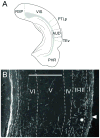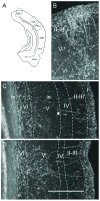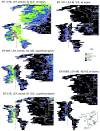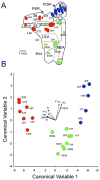Cortical efferents of the perirhinal, postrhinal, and entorhinal cortices of the rat
- PMID: 19360714
- PMCID: PMC3066185
- DOI: 10.1002/hipo.20578
Cortical efferents of the perirhinal, postrhinal, and entorhinal cortices of the rat
Abstract
We investigated the cortical efferents of the parahippocampal region by placing injections of the anterograde tracers, Phaseolus vulgaris-leuccoagglutinin, and biotinylated dextran amine, throughout the perirhinal (PER), postrhinal (POR), and entorhinal cortices of the rat brain. The resulting density of labeled fibers was evaluated in 25 subregions of the piriform, frontal, insular, temporal, cingulate, parietal, and occipital areas. The locations of labeled terminal fibers differed substantially depending on whether the location of the injection site was in PER area 35, PER area 36, POR, or the lateral or the medial entorhinal (LEA and MEA). The differences were greater for sensory regions. For example, the POR efferents preferentially target visual and spatial regions, whereas the PER efferents target all sensory modalities. The cortical efferents of each region largely reciprocate the cortical afferents, though the degree of reciprocity varied across originating and target regions. The laminar pattern of terminal fibers was consistent with the notion that the efferents are feedback projections. The density and amount of labeled fibers also differed substantially depending on the regional location of injection sites. PER area 36 and POR give rise to a greater number of heavy projections, followed by PER area 35. LEA also gives rise to widespread cortical efferents, arising mainly from a narrow band of cortex adjacent to the PER. In contrast, the remainder of the LEA and the MEA provides only weak efferents to cortical regions. Prior work has shown that nonspatial and spatial information is transmitted to the hippocampus via the PER-LEA and POR-MEA pathways, respectively. Our findings suggest that the return projections follow the same pathways, though perhaps with less segregration.
Figures














References
-
- Aggleton JP, Neave N, Nagle S, Hunt PR. A comparison of the effects of anterior thalamic, mamillary body and fornix lesions on reinforced spatial alternation. Behavioual Brain Research. 1995;68:91–101. - PubMed
-
- Agster KL. [doctoral] Providence, RI: Brown University; 2007. Structure and function of the rodent postrhinal cortex: Comparisons to other cortical regions; p. 317.
-
- Arnault P, Roger M. Ventral temporal cortex in the rat: Connections of secondary auditory areas Te2 and Te3. J Comp Neurol. 1990;302:110–123. - PubMed
-
- Beckstead RM. Afferent connections of the entorhinal area in the rat as demonstrated by retrograde cell-labeling with horseradish peroxidase. Brain Res. 1978;152:249–264. - PubMed
-
- Bucci DJ, Burwell RD. Deficits in attentional orienting following damage to the perirhinal or postrhinal cortices. Behav Neurosci. 2004;118(5):1117–1122. - PubMed
Publication types
MeSH terms
Substances
Grants and funding
LinkOut - more resources
Full Text Sources

